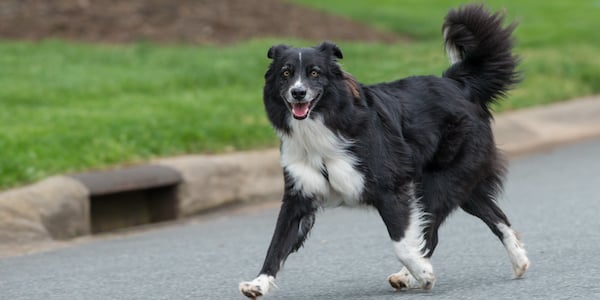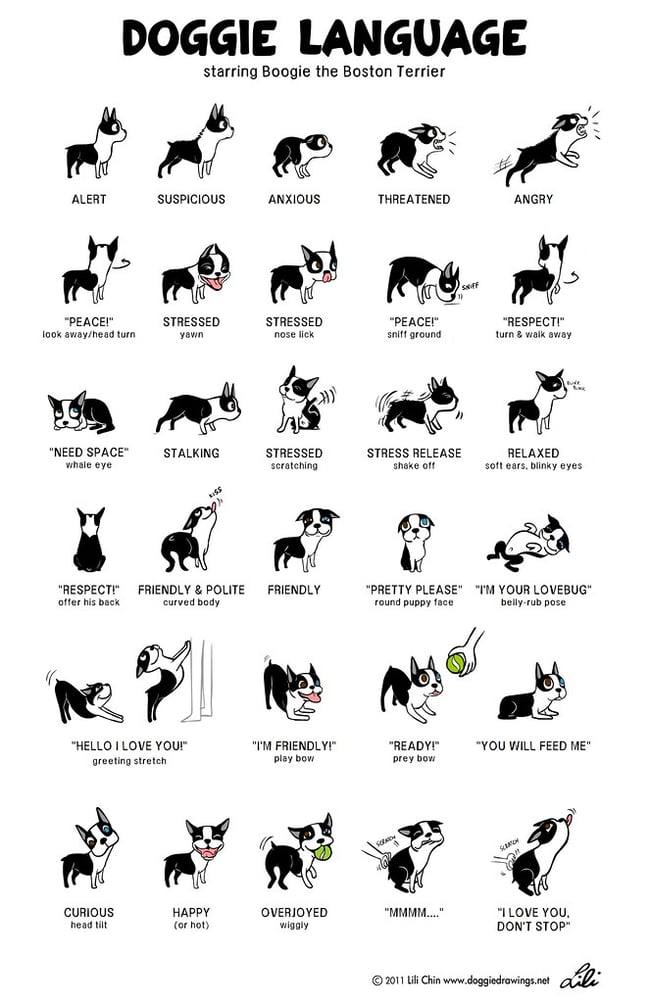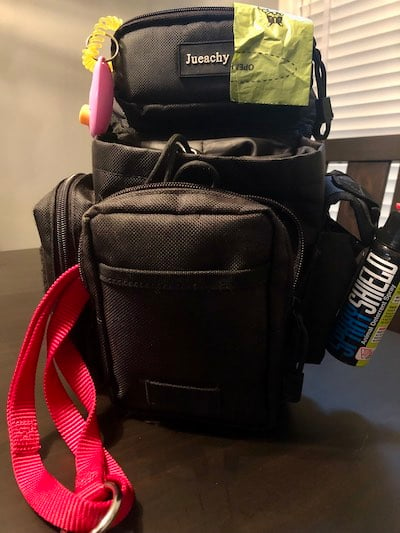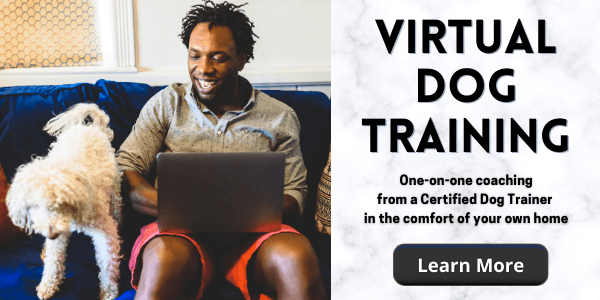 Having a loose dog approach you and your dog while you’re out enjoying a walk can be a nerve-racking experience.
Having a loose dog approach you and your dog while you’re out enjoying a walk can be a nerve-racking experience.
I've not only heard many stories of off leash dogs rushing up to clients of mine, but I've also experienced this with my own dogs and when working with client dogs in training sessions. It's amazing how often this happens, considering how quickly it could go wrong and end up in a dog fight.
Is the dog friendly or will they bite? Are they a stray or did they escape from their yard somewhere nearby? Where is their owner? Are they wanting to come to play with your dog or are they protecting their territory?
This scenario happens more than it should and it can be terrifying, especially if your dog has had bad experiences with off-leash dogs in the past or you have a leash reactive dog who needs their space. Plus, it's just rude for people to let their off leash dogs approach other people and dogs.
Whether a dog has gotten loose from their owner (or the owner has decided to just ignore leash laws in the first place), or if it's a stray dog wandering the area, an off-leash dog coming to investigate a leashed dog is a situation that you should try to avoid at all times.
The dynamics between a leashed dog and an off-leash dog are different than if both dogs were leashed or both were off-leash. Being on leash removes a dog's ability to move away and add distance from the other – we've essentially removed the "flight" option. This leaves them feeling more defensive and reactive, as all that's left is either shutting down (helplessness) or the fight response. It’s best to save the greetings for another time, when both owners are present, the dogs are either both leashed or both off-leash, and after you’ve had a chance to find out more about the other dog’s behavior and health history.
So what should you do if you’re out on a walk with your pup and you see a loose dog approaching? There is inherent danger and risk to having a loose dog coming towards you and your dog. The following techniques may help keep your dog safe but every situation is unique. Use your best judgment. You could be putting yourself in harm's way in order to try and protect your dog. Hopefully, the approaching dog is friendly and no one gets hurt.
Stay Calm & Examine Body Language
Move Away & Between Dogs
Stop & Block Dog's Approach
Be Prepared
How to Deal With an Off Leash Dog
Stay Calm and Examine Dog Body Language
This can be hard! But the calmer you are, the calmer your dog will be. Off-leash dogs are one of the main reasons that you should be practicing constant situational awareness while out walking your dog. The earlier you see the dog approaching, the easier it is to prevent any problems.
Take stock of the approaching dog's body language. A dog who is happy with friendly intentions will have a very loose and bouncy body, relaxed ears and face, an open (panting) mouth, and a relaxed "full-body wag" of the tail. Even if the approaching dog seems to be friendly, it's still better to avoid having your dog greet it. It's a nightmare for owners of dogs who are reactive towards or fearful of dogs to have a "friendly" dog approach.
Friendly dogs can become unfriendly if your dog reacts defensively, and you can't be sure if they're up-to-date on their vaccinations or have other transmittable health issues. However, it's usually easier to get these dogs to stop and leave you and your dog alone using cues, body blocking, or tossing treats away from you.
A dog that is approaching in a more intense fashion, exhibiting body language such as staring at your dog, closed mouth, forward ears, high and tight tail wag, stiffness, and stalking movements, is a dog that you should be more worried about. That intense body language means they are hyper-focused on your dog and might view them as a threat that needs to be dealt with or a prey animal that they should go after. In these instances, you might need to rely on the block and startle techniques to keep you and your dog safe.

The body language of the approaching dog (and your own dog's reactions to other dogs while on leash) will determine the urgency and intensity with which you will need to act.
Move Away and Place Your Dog Behind You
If you have time and enough distance, simply walk a different way with your dog. Use a treat to distract your dog and keep their focus on you as you walk away. Stay aware of where the loose dog is as you make your way out of the area. Avoiding contact with the off-leash dog is the best option!
However, if the dog is coming too quickly towards your dog, you might not have time to escape the area without first distracting the approaching dog. Look around to see who else might be nearby to help call the dog away and look for an easy escape route.
Consider if there is a safe place you can put your dog (if they're small enough to lift) where the other dog can't reach them — such as a bed of a pickup truck, or on top of a dumpster or car. There's even a story of a woman who put her small dachshund inside a large empty trash can to protect it from an aggressively charging large dog. It might seem unconventional, but her dog stayed out of harm's way and it allowed her to safely manage the other dog.
Another option to keep your dog in one place and free up your hands to deal with the other dog is to tether them to a fence, tree, or pole, if there is one nearby. I recommend keeping a carabiner attached to your leash handle for this situation.
Practicing a safety stay with your dog can be really helpful in these situations. Watch this tutorial by Kikopup on the safety stay to learn how to add this to your training toolkit. Being able to trust that your dog will stay in one spot while you deal with the approaching dog makes a stressful situation a bit easier to deal with. Cue your dog to stay and step in front of them so you are in between them and the approaching dog.
Stop or Block the Dog's Approach
There are a few ways you can try to stop a dog in their tracks as they are coming towards you.
- Tell the dog in a loud, firm voice to "Go Home!" or ask for another basic behavior like "Sit."
- Step forward and put your hand out in a stop motion. Use your body to block space and access of the approaching dog. Continue to stay between them and your dog as you make your way out of the area.
- Throw treats at the dog as a distraction. If a dog is approaching rapidly you can even throw the treats directly at their face to break their focus. While they are searching for the treats on the ground, you have time to get away with your dog. Patricia McConnell shows this treat tossing technique in this video:
- Block and startle. You can carry an umbrella and pop it open in the direction of the approaching dog. Often this startles them enough to scare them away. Some dog owners carry a can of compressed air or citronella spray like this SprayShield Deterrent Spray.
These startle techniques should be used as a last resort — they can be extremely stressful for your own dog. Avoid using any kind of pepper spray. It's inhumane, and not only can it blowback towards you and your own dog causing issues with your sight and response, but it can trigger or intensify aggressive behavior from the approaching dog. - If a scuffle between dogs, you need to know how to break up a dog fight safely. Often, how people pull dogs apart can cause more injury to the dogs or cause redirected bites to people. And kicking at or hitting a dog can often backfire and usually doesn't work. Read how to break up a dog fight the right way here.
Be Prepared for When an Off Leash Dog Approaches
 The most you can do while out walking your dog is be prepared for the possibility of an off-leash dog encounter. Beyond being mentally prepared with a plan of action, bring a fanny pack along on your walks with the following supplies:
The most you can do while out walking your dog is be prepared for the possibility of an off-leash dog encounter. Beyond being mentally prepared with a plan of action, bring a fanny pack along on your walks with the following supplies:
- Dog treats
- Deterrent citronella spray or compressed air
- Slip leash for leashing an off-leash dog (who may not be wearing a collar!)
Other options include using an umbrella, popping it open towards the approaching dog to startle it away. However, do be aware that your dog will need to be conditioned to such a loud and potentially scary thing as well - you don't want them bolting off the opposite direction!
One of the best ways to always be prepared is to wear a dog training belt or "kit." You can see the one I wear in the inset picture. This is how I keep all of these emergency supplies on me but keep my hands free. Learn how to create your own dog training belt here.
I've had a few encounters with off-leash dogs while out walking mine, and it doesn't get any less scary each time. However, by learning to read dog body language and being prepared, I've been able to keep my dog safe and prevent a dog fight.
If your dog has had a bad experience when approached by off-leashed dogs, connect with a certified dog trainer or behavior consultant to get help. It's important that both of you can learn to enjoy walks together again and stay as safe as possible!




